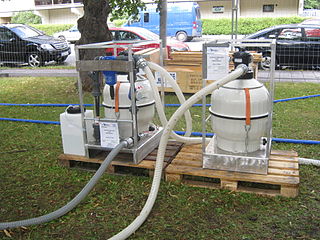 W
WCamping is an outdoor activity involving overnight stays away from home with or without a shelter, such as a tent or a recreational vehicle. Typically participants leave developed areas to spend time outdoors in more natural ones in pursuit of activities providing them enjoyment. The night spent outdoors distinguishes camping from day-tripping, picnicking, and other similarly short-term recreational activities.
 W
WA campfire is a fire at a campsite that provides light and warmth, and heat for cooking. It can also serve as a beacon, and an insect and predator deterrent. Established campgrounds often provide a stone or steel fire ring for safety. Campfires are a popular feature of camping. At summer camps, the word campfire often refers to an event at which there is a fire. Some camps refer to the fire itself as a campfire.
 W
WThe Campfire ash ceremony is a ritual associated with Scouting meant to convey the long history and fellowship associated with the movement. Attributed to Lord Baden-Powell, it is said that he would take a small amount of the ashes from the campfire he was at, and would take them to add to the next campfire he attended.
 W
WBackcountry camping food includes ingredients used to prepare food suitable for backcountry camping and backpacking. The foods differ substantially from the ingredients found in a typical home kitchen. The primary differences relate to campers' and backpackers' special needs for foods that have appropriate cooking time, perishability, weight, and nutritional content.
 W
WA campsite or camping pitch is a place used for overnight stay in an outdoor area. In UK English, a campsite is an area, usually divided into a number of pitches, where people can camp overnight using tents, campervans or caravans; this UK English use of the word is synonymous with the US English expression campground. In American English, the term campsite generally means an area where an individual, family, group, or military unit can pitch a tent or park a camper; a campground may contain many campsites.
 W
WCanoe camping, also known as touring, tripping or expedition canoeing, is a combination of canoeing and camping. Like backpacking, canoe campers carry enough with them to travel and camp for several days, but do so via a canoe or kayak.
 W
WDispersed Camping is the term given to camping in the United States on public land other than in designated campsites. This type of camping is most common on national forest and Bureau of Land Management land. Designated campsites often offer services to the campers, such as trash removal, toilet facilities, tables and/or fire pits, which are not available at dispersed camping locations. Although dispersed camping takes place on public land, each managing agency has specific regulations for dispersed camping, though they generally all also require campers to follow Leave No Trace guidelines. Other terms used for this type of camping can be boondocking, dry camping or wild camping.
 W
WGlamping is a portmanteau of "glamorous" and "camping", and describes a style of camping with amenities and, in some cases, resort-style services not usually associated with "traditional" camping. Glamping has become particularly popular with 21st century tourists seeking the luxuries of hotel accommodation alongside "the escapism and adventure recreation of camping".
 W
WHammock camping is a form of camping in which a camper sleeps in a suspended hammock rather than a conventional tent on the ground. Due to the absence of poles and the reduced amount of material used, they tend to be significantly lighter than a tent. Their reduced weight often results in less space inside than a similar occupancy tent. In foul weather, a tarp is suspended above the hammock to keep the rain off of the camper. Mosquito netting, sometimes integrated into the camping hammock itself, is also used as climatic conditions warrant. Camping hammocks are used by campers who are looking for lighter weight, protection from ground-dwelling insects, or other ground complications such as sloped ground, rocky terrain and flooded terrain.
 W
WA lean-to is a type of simple structure originally added to an existing building with the rafters "leaning" against another wall. Free-standing lean-to structures are generally used as shelters. One traditional type of lean-to is known by its Finnish name laavu.
 W
WA motorhome is a type of self-propelled recreational vehicle (RV) which offers mobile living accommodation.
 W
WOutdoor cooking differs substantially from kitchen-based cooking, the most obvious difference being lack of an easily defined kitchen area. As a result, campers and backpackers have developed a significant body of techniques and specialized equipment for preparing food in outdoors environments. Such techniques have traditionally been associated with nomadic cultures such as the Berbers of North Africa, the Arab Bedouins, the Plains Indians, pioneers in North America, and indigenous tribes in South America. These methods have been refined in modern times for use during recreational outdoors pursuits.
 W
WPortable water purification devices are self-contained, easily transported units used to purify water from untreated sources for drinking purposes. Their main function is to eliminate pathogens, and often also of suspended solids and some unpalatable or toxic compounds.
 W
WA recreational vehicle, often abbreviated as RV, is a motor vehicle or trailer which includes living quarters designed for accommodation. Types of RVs include motorhomes, campervans, coaches, caravans, fifth-wheel trailers, popup campers, and truck campers.
 W
WA tent pad is a designated area at a campground site to a set up a tent. It eliminates the need to find a suitable spot to pitch a tent.
 W
WA campervan, sometimes referred to as a camper, caravanette, or motor caravan, is a self-propelled vehicle that provides both transport and sleeping accommodation. The term mainly describes vans that have been fitted out, often with a coachbuilt body for use as accommodation.